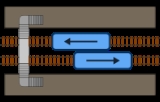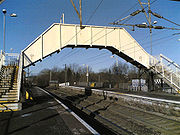
Side platform
Encyclopedia


Railway platform
A railway platform is a section of pathway, alongside rail tracks at a train station, metro station or tram stop, at which passengers may board or alight from trains or trams. Almost all stations for rail transport have some form of platforms, with larger stations having multiple platforms...
positioned to the side of a pair of tracks at a railway station, a tram stop
Tram stop
A tram stop is a place designated for a tram to stop so passengers can board or alight it. Tram stops share most characteristics of bus stops, but because trams operate on rails, they often include railway platforms, especially if stepless entries are provided for accessibility...
or a transitway. A pair of side platforms are often provided on a dual track line with a single side platform being sufficient for a single track line. An alternative arrangement is to use an island platform
Island platform
An island platform is a station layout arrangement where a single platform is positioned between two tracks within a railway station, tram stop or transitway interchange...
where a single platform is sandwiched between a pair of tracks which divide to accommodate the platform. Side platforms may result in a wider overall footprint for the station compared to an island platform where a single width of platform can be 'shared' by both tracks.
Layout
Where the station is close to a level crossingLevel crossing
A level crossing occurs where a railway line is intersected by a road or path onone level, without recourse to a bridge or tunnel. It is a type of at-grade intersection. The term also applies when a light rail line with separate right-of-way or reserved track crosses a road in the same fashion...
(grade crossing) the platforms may either be on the same side of the crossing road or alternatively may be staggered in one of two ways. With the 'near-side platforms' configuration, each platform appears before the intersection and with 'far-side platforms' they are positioned after the intersection.
In some situations a single side platform can be served by multiple vehicles simultaneously with scissors crossing (points) being provided to allow access mid-way along its length.
Most stations with two side platforms have an 'Up' platform which is used by trains heading towards the primary destination of the line, with the other platform being the 'Down' platform which takes trains heading the opposite way. Normally, the main facilities of the station are located on the 'Up' platform with the other platform accessed from a footbridge, subway or a track crossing. However, in many cases the station's main buildings are located on whichever side faces the town or village the station serves.
Larger stations may have two side platforms with several island platforms in between.

